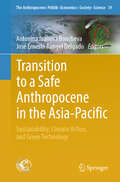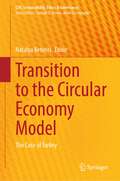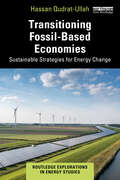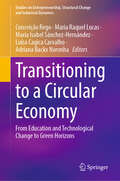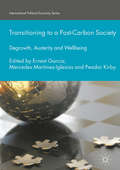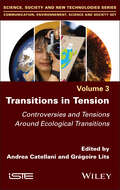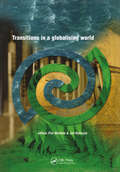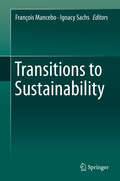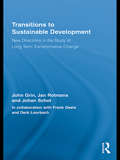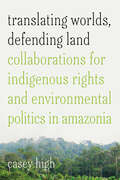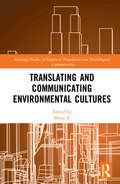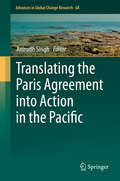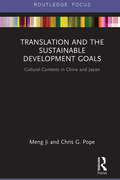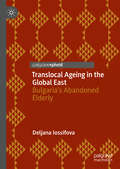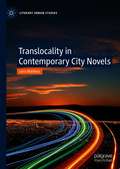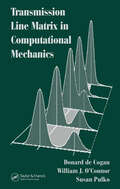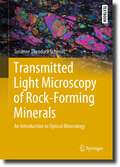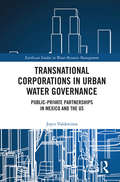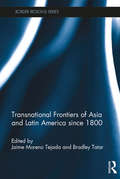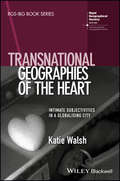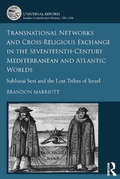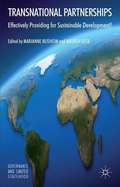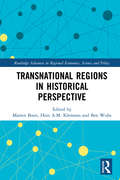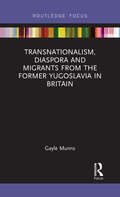- Table View
- List View
Transition to a Safe Anthropocene in the Asia-Pacific: Sustainability, Climate Action, and Green Technology (The Anthropocene: Politik—Economics—Society—Science #39)
by José Ernesto Rangel Delgado Antonina Ivanova BonchevaThe Anthropocene concept highlights that we are now living in a new epoch of earth history where both the rapid accumulation of greenhouse gases and excessive consumption of natural resources endanger human and planetary wellbeing. Climate change is one of the main drivers of the Anthropocene and is intricately linked to many great challenges we face: lack of fresh water, food security, biodiversity loss, and human rights of present and future generations. The radical influence of humanity on nature must change from destructive to reconstructive, by the path of sustainable development, circular economy, climate action, green technology, and environmental awareness. This book explores the pathways of transition towards a safe and sustainable Anthropocene in the Asia-Pacific and reviews the progress and the challenges in climate action, the recovery from COVID-19, and the re-articulation of world order. The chapters address both regional and country levels, the majority analysing China and Mexico. The experiences presented can be replicated in other regions of the world. The book offers useful insights for all interested in the Anthropocene, in climate action, sustainability, and the relationship between human beings and nature, thus motivating the decision-makers to implement a just and inclusive transition to a safe Anthropocene. • A novel study that explores links between the Anthropocene, climate change, and sustainability, framing the transition towards a safe and sustainable Anthropocene in the Asia-Pacific. • Strategies and policies on climate action, renewable energies, green technology, and environmental education include the participation of governments, NGOs, and civil society. • Case studies based on experiences at the regional and country level provide valuable insights for both industrialised and developing countries.
Transition to the Circular Economy Model: The Case of Turkey (CSR, Sustainability, Ethics & Governance)
by Natalya KetenciThis edited volume provides a multisectoral, multidisciplinary analysis of the circular economy in Turkey. The chapters delve into different segments of the economy, monitoring the progress of the transition to circularity as it is occurring. Written by experts in the circular economy, chapters touch on different aspects of the sustainability transition—from AI and entrepreneurship to luxury fashion to green finance. Chapters also refer directly to applicable UN Sustainable Development Goals, noting the progress made towards related development targets. This volume will be of use to students, academicians, experts, and professionals interested and working on different aspects of circular and green economies.
Transitioning Fossil-Based Economies: Sustainable Strategies for Energy Change (Routledge Explorations in Energy Studies)
by Hassan Qudrat-UllahThis book offers a comprehensive exploration of the role of fossil-based economies in the global energy transition toward sustainability.The book’s main themes include understanding the challenges and opportunities inherent in transitioning from fossil fuels to renewable energy sources, analyzing the economic, environmental, and social impacts of this transition, and identifying strategies for fostering sustainable practices within fossil-based economies. Through a multidisciplinary lens, this book navigates the complex dynamics of transitioning from fossil fuels to sustainable energy sources, addressing environmental, economic, and social dimensions. From understanding the challenges and opportunities posed by fossil-based practices to exploring successful case studies of green transitions, this book offers actionable insights for policymakers, practitioners, and stakeholders alike. The case studies showcase a range of real-world examples of successful green transitions and initiatives within fossil-based economies. With a visionary approach and a call for collaborative global efforts, this book advocates for a sustainable, equitable, and resilient energy future.This book will be useful for students and researchers studying energy transitions, sustainability, environmental economics, and global policy. It will appeal to professionals working in government agencies, energy companies, environmental organizations, international development agencies, and academic institutions.
Transitioning to a Circular Economy: From Education and Technological Change to Green Horizons (Studies on Entrepreneurship, Structural Change and Industrial Dynamics)
by Luísa Cagica Carvalho Conceição Rego Adriana Backx Noronha Maria Raquel Lucas María Isabel Sánchez-HernándezThis comprehensive book addresses the multifaceted challenges posed by technological innovation, ecological transitions, and sustainable business practices. Drawing on extensive research in the circular economy and green, inclusive transitions, it serves as an essential reference for scholars, researchers, and practitioners. In today’s global landscape, quality of life transcends economic indicators like GDP. True well-being and happiness are influenced by a myriad of factors beyond financial wealth. Social and environmental domains are crucial to ensuring that no individual or community is left behind. This commitment aligns with the Sustainable Development Goals (SDGs) framework, emphasizing holistic sustainability.
Transitioning to a Post-Carbon Society
by Peadar Kirby Ernest Garcia Mercedes Martinez-IglesiasThis book deals with one of the most pressing social and environmental issues that we face today. The transition to a post-carbon society, in which the consumption of fossil fuels decreases over time, has become an inevitability due to the need to prevent catastrophic climate change, the increasing cost and scarcity of energy, and complex combinations of both of these factors. As the authors point out, this will not only entail political adjustments and the replacement of some technologies by others, but will be accompanied by social and cultural changes that bring about substantial modifications in our societies and ways of life. This book examines whether the current conditions, which date back to the crisis that began in 2007, favour a benign and smooth transition or will make it more difficult and prone to conflict. It argues that, even if this transformation is unavoidable, the directions it will take and the resulting social forms are much less certain. There will be many post-carbon societies, the authors conclude, and any number of routes to social change. Transitioning to a Post-Carbon Society therefore represents a significant contribution to global debates on the environment, and is vital reading for academics, policymakers, business leaders, NGOs and the general public alike.
Transitions in Tension, Volume 3: Controversies and Tensions Around Ecological Transitions (ISTE Invoiced)
by Andrea Catellani Grégoire LitsTransitioning towards a more sustainable world is currently a central topic receiving a lot of attention. As a result, “transitions” are becoming key objects and the drivers of exchanges, communications and controversy in modern society. This book examines the tensions and controversies surrounding the energy, ecological and social transitions currently underway, and it draws on tools developed in the humanities and social sciences, in particular the information and communication sciences. The various case studies gathered here, written by leading experts in environmental communication, examine a wide range of topics; they explore transitions in a number of different fields, from agriculture to territorial policies, and from online and media communication to mechanisms for citizen participation. Transitions in Tension features a wealth of original observations and approaches, enabling readers to fully comprehend the range of controversies and issues facing our society
Transitions in a Globalising World
by Pim Martens; Jan RotmansThe Earth System may be the most complex entity that ever emerged in our galaxy and the contemporary process of 'globalisation' may be the most intricate dynamics that will ever pervade that entity: it is the interactive co-evolution of millions of technological, cultural, economic, social and environmental trends at all conceivable spatiotemporal scales that brings about the present fundamental transformation of humanity’s way of life. In this text the authors make the heroic effort to tame the complexity of modern planetary development by the intellectual concept of 'transition'. In this work, four major issues are discussed that are of global importance: developments related to two of our key natural resources; water and biodiversity; the health of human populations; and the developments related to global tourism.
Transitions to Sustainability
by Ignacy Sachs François ManceboThis book calls for the conditions of transition to sustainability: How to take into consideration new global phenomena such as and of the dimension of climate change, the depletion of natural resources, financial crises, demographic dynamics, global urbanization, migrations and mobility, while bearing in mind short-term or local place-based issues, such as social justice or quality of life? Meeting this challenge requires an inclusive approach of sustainability. It is a matter of designing a new social contract: Sustainability requires more than developing the right markets, institutions and metrics, it requires social momentum. To do so, many issues need a clear and complete answer: How to link social justice with sustainability policies? What governance tools to do so? What linkage between one decision-making level and the other? These are major issues to design sound transitions to sustainability.
Transitions to Sustainable Development: New Directions in the Study of Long Term Transformative Change (Routledge Studies in Sustainability Transitions)
by Johan Schot John Grin Jan RotmansOver the past few decades, there has been a growing concern about the social and environmental risks which have come along with the progress achieved through a variety of mutually intertwined modernization processes. In recent years these concerns are transformed into a widely-shared sense of urgency, partly due to events such as the various pandemics threatening livestock, and increasing awareness of the risks and realities of climate change, and the energy and food crises. This sense of urgency includes an awareness that our entire social system is in need of fundamental transformation. But like the earlier transition between the 1750's and 1890's from a pre-modern to a modern industrial society, this second transition is also a contested one. Sustainable development is only one of many options. This book addresses the issue on how to understand the dynamics and governance of the second transition dynamics in order to ensure sustainable development. It will be necessary reading for students and scholars with an interest in sustainable development and long-term transformative change.
Translating Worlds, Defending Land: Collaborations for Indigenous Rights and Environmental Politics in Amazonia
by Casey HighIn 2019, after decades of ecological damage from oil, Waorani people took to the streets of Amazonian Ecuador to protest drilling on their ancestral lands. Working with international activists, lawyers, and other Indigenous groups, they successfully sued the government for selling oil concessions without prior consent. Placing their struggle for territorial autonomy in the global spotlight, this unprecedented legal victory for environmental rights by an Indigenous people reflected the new forms of collaboration emerging in contemporary Amazonia. Translating Worlds, Defending Land explores how Waorani collaborations, whether with environmentalists or academic researchers, bring about new possibilities, challenges, and imaginative horizons. Based on fieldwork over a period of twenty-five years, Casey High interrogates what these engagements mean for Indigenous communities and how they offer critical reflection on collaboration as a concept, method, and practice. The alliances, misunderstandings, and conflicts that emerge in these contexts challenge the assumption that productive collaborations reflect—or require—shared purposes, generating important implications for an engaged anthropology open to reconsidering what constitutes ethnographic knowledge and who it is for. As some young Waorani adults become not just community leaders or environmental citizens, but also skilled researchers and ethnographers, translating between Indigenous understandings of land and the Western language conservation, they create a powerful new voice in international environmental politics.
Translating and Communicating Environmental Cultures (Routledge Studies in Empirical Translation and Multilingual Communication)
by Meng JiEnvironmental translation studies has gained momentum in recent years as a new area of research underscored by the need to communicate environmental concerns and studies across cultures. The dissemination of translated materials on environmental protection and sustainable development has played an instrumental role in transforming local culture and societies. This edited book represents an important effort to advance environmental studies by introducing the latest research on environmental translation and cross-cultural communication. Part I of the book presents the newest research on multilingual environmental resource development based at leading research institutes in Europe, Latin America, North America, and the Asia-Pacific. Part II offers original, thought-provoking linguistic, textual and cultural analyses of environmental issues in genres as diverse as literature, nature-based tourism promotion, environmental marketing, environmental documentary, and children’s reading. Chapters in this book represent original research authored by established and mid-career academics in translation studies, computer science, linguistics, and environmental studies around the world. The collection provides engaging reading and references on environmental translation and communication to a wide audience across academia.
Translating the Paris Agreement into Action in the Pacific (Advances in Global Change Research #68)
by Anirudh SinghThis book provides an insight into how a country contributes to the GHG emissions reductions required to keep global warming within the limits set by the Paris Agreement arrived at COP21 in 2015. It shows what actions are needed for the implementation plan that Fiji will use to satisfy its quota (i.e. its Nationally Determined Contribution or NDC) of the total GHG emissions reductions. It is a primary resource material for those who wish to obtain an understanding of the science behind climate change mitigation. It reveals the behind-the-scenes action that takes place to convert the rhetoric of climate change into the action on the ground that actually reduces the GHG emissions and global warming. The book also presents a critique of methods adopted by nations in meeting their NDCs to emissions reductions as agreed at the Paris Agreement, and suggests improvements.
Translation and the Sustainable Development Goals: Cultural Contexts in China and Japan (Routledge Focus on Public Governance in Asia)
by Meng Ji Chris G. PopeThis book offers insight into the use of empirical diffusionist models for analysis of cross-cultural and cross-national communication, translation and adaptation of the United Nation’s (UN) Sustainable Development Goals (SDGs). The book looks at three social analytical instruments of particular utility for the cross-national study of the translation and diffusion of global sustainable development discourses in East Asia (China and Japan). It explains the underlying hypothesis that, in the transmission and adaptation of global SDGs in different national contexts, three large groups of social actors encompassing sources of information, mediating actors and socio-industrial end-users form, shape and contribute to the complex, latent networks of social engagement. It illuminates how the distribution within these networks largely determines the level and breadth of the diffusion of global SDGs and their associated environmentalist norms. This book is an essential read for anyone interested in sustainable growth and development, as well as global environmental politics.
Translocal Ageing in the Global East: Bulgaria’s Abandoned Elderly
by Deljana IossifovaThis book is about ageing in Bulgaria. How do Bulgaria’s elderly—abandoned by the state and left behind by their adult children and grandchildren—adapt to their continuously shifting environment and a state of perpetual uncertainty? Drawing on dozens of interviews with older people in Bulgaria’s capital Sofia as well as a village in the Bulgarian Balkans, Iossifova unravels how the dramatic socio-political transitions of the past eighty years have influenced the lifecourse of older people today. She carefully traces their patterns of everyday life in order to draw out the mechanisms through which older people cope with their meagre pensions, sustain their ailing bodies and make do in their tattered homes. Iossifova argues that ‘ageing in place’ as a popular paradigm underpinning neoliberal policy agendas has no place in Bulgaria and the wider Global East, where translocal ageing is the norm.
Translocality in Contemporary City Novels (Literary Urban Studies)
by Lena MattheisTranslocality in Contemporary City Novels responds to the fact that twenty-first-century Anglophone novels are increasingly characterised by translocality—the layering and blending of two or more distant settings. Considering translocal and transcultural writing as a global phenomenon, this book draws on multidisciplinary research, from globalisation theory to the study of narratives to urban studies, to explore a corpus of thirty-two novels—by authors such as Chimamanda Ngozi Adichie, Dionne Brand, Kiran Desai, and Xiaolu Guo—set in a total of ninety-seven cities. Lena Mattheis examines six of the most common strategies used in contemporary urban fiction to make translocal experiences of the world narratable and turn them into relatable stories: simultaneity, palimpsests, mapping, scaling, non-places, and haunting. Combining and developing further theories, approaches, and techniques from a variety of research fields—including narratology, human geography, transculturality, diaspora spaces, and postcolonial perspectives—Mattheis develops a set of cross-disciplinary techniques in literary urban studies.
Transmission Line Matrix (TLM) in Computational Mechanics
by Donard de Cogan William J. O'Connor Susan PulkoThe finite element method reigns as the dominant technique for modeling mechanical systems. Originally developed to model electromagnetic systems, the Transmission Line Matrix (TLM) method proves to match, and in some cases exceed, the effectiveness of finite elements for modeling several types of physical systems. Transmission Line Matrix in Compu
Transmitted Light Microscopy of Rock-Forming Minerals: An Introduction to Optical Mineralogy (Springer Textbooks in Earth Sciences, Geography and Environment)
by Susanne Theodora SchmidtThis book presents a guide of optical mineralogy for beginners and microscopists who need to brush up their knowledge. It allows the fast identification of common rock-forming minerals in a thin section using a polarized light microscope and transmitted plane and cross polarized light. The book summarizes essential principles of optical mineralogy in numerous schemes. It explains, with the aid of more than 1000 microscopic images, how to determine the diagnostic optical characteristics of a mineral in a thin section. Seventy-two mineral plates of sixty-five common rock-forming minerals comprising typical microscopic images in plane and cross polarized light illustrate the most important optical and crystallographic parameters and their diagnostic characteristics and typical appearance in various geological settings. The original approach of the book is to facilitate mineral identification by mineral plates organized according to color in transmitted plane polarized light and, in each color category, according to decreasing maximum birefringence in cross polarized light. In addition, two chapters are devoted to the classification of magmatic and metamorphic rocks and their common mineral parageneses and textures.The book reflects the author’s experience of teaching optical mineralogy in the most efficient way possible to generations of students at the Universities of Heidelberg (Germany), Basel (Switzerland), and Geneva (Switzerland).
Transnational Climate Change Governance
by Stacy D. Vandeveer Daniel Compagnon Harriet Bulkeley Thomas Hale Peter Newell Charles Roger Harriet Bulkeley Liliana B. Andonova Michele M. Betsill Daniel Compagnon Thomas Hale Matthew J. Hoffmann Peter Newell Matthew Paterson Charles Roger Liliana B. Andonova Michele M. Betsill Matthew J. Hoffmann Matthew PatersonThe world of climate politics is increasingly no longer confined to the activities of national governments and international negotiations. Critical to this transformation of the politics of climate change has been the emergence of new forms of transnational governance that cut across traditional state-based jurisdictions and operate across public and private divides. This book provides the first comprehensive, cutting-edge account of the world of transnational climate change governance. Co-authored by a team of the world's leading experts in the field and based on a survey of sixty case studies, the book traces the emergence, nature and consequences of this phenomenon, and assesses the implications for the field of global environmental politics. It will prove invaluable for researchers, graduate students and policy makers in climate change, political science, international relations, human geography, sociology and ecological economics.
Transnational Corporations in Urban Water Governance: Public-Private Partnerships in Mexico and the US (Earthscan Studies in Water Resource Management)
by Joyce ValdovinosThis book examines the role played by business in urban water governance by analyzing the evolution of the global private water sector along with four public-private partnerships in Mexico and the U.S. The local nature of water services often hides the global developments behind the rise of transnational water corporations, which have gone from being local operators to becoming dynamic and powerful actors within an interconnected transnational space for water. This book focuses on the French groups Veolia and Suez, two of the most prominent private actors in global water governance, and the development and adaptation strategies of both companies in the cities of Aguascalientes, Mexico City, Atlanta, and Milwaukee over the past 30 years. Drawing on over 100 interviews conducted with corporate executives, public authorities, and local users of water services, this book moves beyond the simplistic dichotomy of the public-private debate and develops a theoretical framework that analyzes the economic and political power wielded by transnational business actors in global water governance. Not only does the book explain how Veolia and Suez strategically mobilize resources at difference scales in order to expand their global operations, but it also provides a nuanced picture of how state regulation remains of central importance to understanding the dynamics and evolution of the global water sector. Students and scholars interested in business and the environment, including public-private partnerships, business management and transnational corporations, and water governance, will find this book of great interest as will professionals and policymakers working in these fields.
Transnational Frontiers of Asia and Latin America since 1800 (Border Regions Series)
by Jaime Moreno Tejada Bradley TatarFrontiers are "wild." The frontier is a zone of interaction between distinct polities, peoples, languages, ecosystems and economies, but how do these frontier spaces develop? If the frontier is shaped by the policing of borders by the modern-nation state, then what kind of zones, regions or cultural areas are created around borders? This book provides 16 different case studies of frontiers in Asia and Latin America by interdisciplinary scholars, charting the first steps toward a transnational and transcontinental history of social development in the borderlands of two continents. Transnationalism provides a shared focus for the contributions, drawing upon diverse theoretical perspectives to examine the place-making projects of nation states. Through the lenses of different scales and time frames, the contributors examine the social processes of frontier life, and how the frontiers have been created through the exertions of nation-states to control marginal or borderland peoples. The most significant cases of industrialization, resource extraction and colonization projects in Asia and Latin America are examined in this book reveal the incompleteness of frontiers as modernist spatial projects, but also their creativity - as sources of new social patterns, new human adaptations, and new cultural outlooks and ways of confronting power and privilege. The incompleteness of frontiers does not detract from their power to move ideas, peoples and practices across borders both territorial and conceptual. In bringing together Asian and Latin American cases of frontier-making, this book points toward a comparativist and cosmopolitan approach in the study of statecraft and modernity. For scholars of Latin America and/or Asia, it brings together historical themes and geographic foci, providing studies accessible to researchers in anthropology, geography, history, politics, cultural studies and other fields of the human sciences.
Transnational Geographies Of The Heart: Intimate Subjectivities In A Globalising City (RGS-IBG Book Series)
by Katie WalshTransnational Geographies of the Heart explores the spatialisation of intimacy in everyday life through an analysis of intimate subjectivities in transnational spaces. Draws on ethnographic research with British migrants in Dubai, United Arab Emirates, during a phase of rapid globalisation and economic diversification in 2002-2004 Highlights the negotiation of inter-personal relationships as enormously significant in relation to the dialectic of home and migration Includes four empirical chapters focused on the production of ‘expatriate’ subjectivities, community and friendships, sex and romance, and families Demonstrates that a critical analysis of the geographies of intimacy might productively contribute to our understanding of the ways in which intimate subjectivities are embodied, emplaced, and co-produced across binaries of public/private and local/global space
Transnational Networks and Cross-Religious Exchange in the Seventeenth-Century Mediterranean and Atlantic Worlds: Sabbatai Sevi and the Lost Tribes of Israel (Universal Reform: Studies in Intellectual History, 1550-1700)
by Brandon MarriottIn 1644, the news that Antonio de Montezinos claimed to have discovered the Lost Tribes of Israel in the jungles of South America spread across Europe fuelling an already febrile atmosphere of messianic and millenarian expectation. By tracing the process in which one set of apocalyptic ideas was transmitted across the Christian and Islamic worlds, this book provides fresh insight into the origin and transmission of eschatological constructs, and the resulting beliefs that blurred traditional religious boundaries and identities. Beginning with an investigation of the impact of Montezinos’s narrative, the next chapter follows the story to England, examining how the Quaker messiah James Nayler was viewed in Europe. The third chapter presents the history of the widely reported - but wholly fictitious - story of the sack of Mecca, a rumour that was spread alongside news of Sabbatai Sevi. The final chapter looks at Christian responses to the Sabbatian movement, providing a detailed discussion of the cross-religious and international representations of the messiah. The conclusion brings these case studies together, arguing that the evolving beliefs in the messiah and the Lost Tribes between 1648 and 1666 can only be properly understood by taking into account the multitude of narrative threads that moved between networks of Jews, Conversos, Catholics and Protestants from one side of the Atlantic to the far side of the Mediterranean and back again. By situating this transmission in a broader historical context, the book reveals the importance of early-modern crises, diasporas and newsgathering networks in generating the eschatological constructs, disseminating them on an international scale, and transforming them through this process of intercultural dissemination into complex new hybrid religious conceptions, expectations, and identities.
Transnational Partnerships
by Marianne Beisheim Andrea LieseWhy are some transnational public-private partnerships (PPPs) highly effective, while others are not? The contributors compare 21 transnational PPPs that seek to provide collective goods in the field of sustainable development.
Transnational Regions in Historical Perspective (Routledge Advances in Regional Economics, Science and Policy)
by Hein A.M. Klemann Ben Wubs Marten BoonNational competitiveness has become a misnomer, as competitiveness is increasingly understood as a regional phenomenon and regions are not confined to the boundaries of the nation state. This book focuses on the Port of Rotterdam and its hinterland – i.e. the Lower Rhine and the Ruhr area. A transnational perspective is imperative to understand the historical trajectories of the port, the hinterland and the region itself. This book brings geography and the transnational study of regions back into the historical discipline, linking places to larger geographical scales and to systems of production and consumption and the global chains in which they are organised. This book will be of interest to scholars and practitioners in urban studies, urban planning, public policy, geography and political science.
Transnationalism, Diaspora and Migrants from the former Yugoslavia in Britain
by Gayle MunroThe geo-political area of what once constituted Yugoslavia has been a region of significant migration since the 1960s. More recently, the conflicts in the region were the catalysts for massive displacements of individuals, families and whole communities. Thus far, there has been a gap in the literature on the qualitative experience of migrants from the former Yugoslavia through the twin theoretical lenses of transnationalism and diaspora. This book offers an ethnographic account of migration and life in diaspora of migrants originating from the former Yugoslavia and now living in Britain. Concepts such as the development of cultural beacons and diasporic borrowing are introduced through the ways in which migrants from the region form community associations and articulate - or avoid - such affiliations. The study examines the ways in which the experience of migration can be shaped by the socio-political contexts of departure and arrival, and considers how the lexicon associated with the act of migration can weave itself into the identities of migrants. The ways in which the transnational and diasporic spaces are dictated by certain narratives, for example the allegory of dreaming and the language of guilt, are explored. It also investigates migrants’ ongoing connection with the homeland, considering social and cultural elements, their reception in UK, and British media representations of Yugoslavia. Contributing to the knowledge on the experiences of migrants from a part of the world which has been under-researched in terms of its migrating populations, this book will be of interest to students and scholars of Political Geography, Social Geography, Eastern European Politics, and Migration and Diaspora studies.
